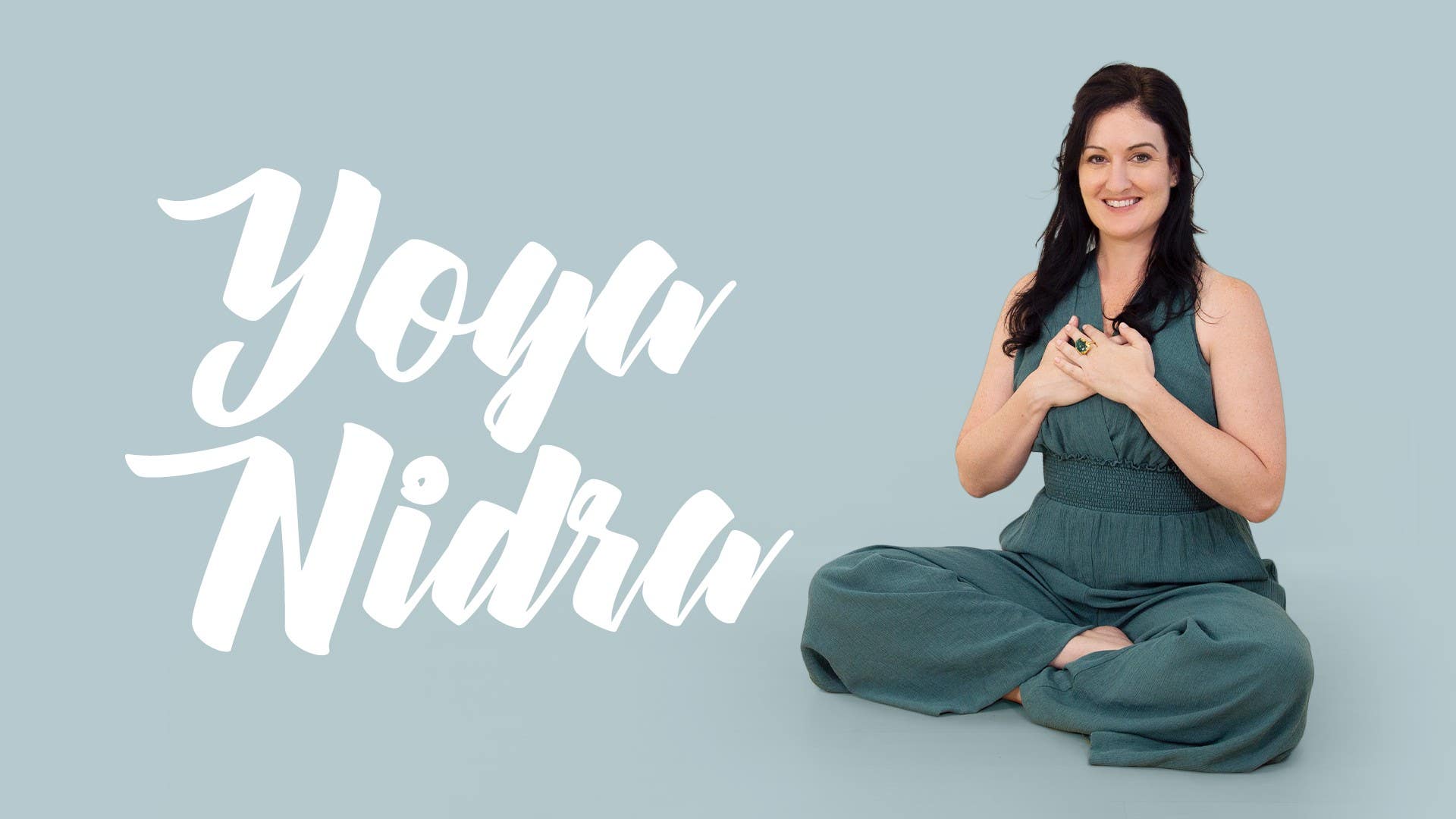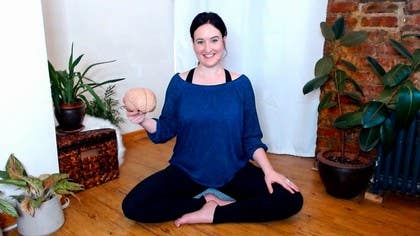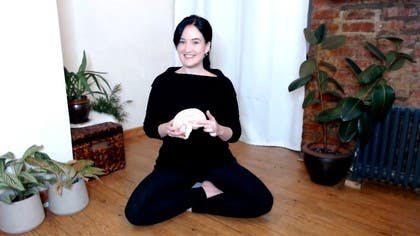Description
Neurons that fire together wire together. We begin in a seated experience of the breath before Kristin leads us to a better understanding of the brain and how we form patterns of thinking and behavior. Kristen then guides us in a Yoga Nidra practice to focus on Gratitude as a way to create new pathways of behavior in the brain. You will feel centered and illuminated.
You can follow along with the Grounding Mantras at the end of each class by accessing the PDF attached below.
About This Video
Transcript
Read Full Transcript
Namaste. So we will start in a comfortable seated position. You can use any of your props to sit upright, you can even come to sit in a chair if that works out better for you. Just want something that you can be more or less comfortable in so you don't have to fidget so much. Otherwise, all you're thinking about is how uncomfortable you are, which is a really boring way to spend 10 minutes of your life or so.
Arrange yourself well in your body, in your chair, on your props. And let's start maybe with the palms face down on our thighs or knees or in our lap in just an effort to land, to grow connected to where we are, what we're feeling, how we're breathing, what we're bringing with us. And as you found the most perfect seat for you to begin, you can close your eyes. And just taking that considerable amount of energy that has been reaching out, refracting out, trying to figure out the world around you and start to take that energy, that awareness and kind of harness it and turn it to look inward to that more internal landscape, internal architecture of your body. Taking time to notice any sensations that you know to be true in your form right now.
Get the same curiosity, noticing the goings on in the mind. I think sometimes there's a desire, like a yoga type desire to want to shut off the mind, quiet the mind, still the mind. Maybe just spending a minute or so perusing the mind. No particular agenda, but just to see it, experience it and how it's showing up in this very transient moment of right now. And let's begin to deepen the breath gradually, gracefully, in and out through the nose if possible.
Just keep tugging on the ends of the breath so each one is just a little bit more noticed, a little bit more relaxed. The yogis note that the mind and the breath follow one another, almost like two fish kind of swimming, one following the other. So by working with the breath, you're in essence working with the fluctuations of the mind. So as you keep tethering your attention towards the breath, these longer streams of breath, let's start to refine the breath, giving it a very soft sound, an ujjayi pranayam, slight hug of the vocal folds, almost like you're whispering. And refining the sound, vibration or felt vibration at the throat as a way of helping to balance your effort and your ease.
It's going to take some effort to harness the focus on the breath, to do this ujjayi, to slow down, to interact with the technique, but if you've got too much efforting here, it's going to sound pretty harsh, like Darth Vader. And you also find a balance in the mind of easefulness, softness as well as a strength. Continuing that ujjayi and start to become aware of the equanimity of both the inhale and exhale phase of breath. So if you're inhaling, say for a count of six, you're exhaling for a count of six. Breathe, inhale and exhale, bring about the qualities of inspiration, taking in engagement and expiring, letting go, surrender.
When you find a balance in the breath and does that then, does the mind follow? And continuing that refinement of the sound of the breath, the equanimity of the breath. And then see if there's any little rough spots, any little kind of staccato bits in the breath, little gasps or stutters. Or even any times where your mind kind of gets distracted by a sound or a thought or an emotion or a knee or an itch, and can you just refine by bringing your sweet attention back or to those little rough spots? Does that make a difference in the mind?
Is that reflected? Does the mind follow? And finishing your next round of breath, take your time to get there. Let all the technique go and just take one minute to simply experience anything that there is there to experience, whether it's physical body sensation, pranic body, mind, mind, or even just the relationship to the part of you that witnesses, that observes it all. And perhaps with a little gratitude, just float a hand up to touch your own heart, bow your head towards your own heart, maybe it's gratitude for your time or for these practices for one another.
As you're ready, you can flutter your eyes open, maybe take a hazy gaze at one point on the floor, taking your time to let the rest of the room come back into your focus. All right, feel free to shake your legs out. Take a little movement in your body if you'd like, and I'd like to start talking about in the next few practices together about the brain, all about the brain. And the brain, for something so small, three pounds or so of the consistency of a soft tofu, so quite squishy, and made up of mostly water and fat. I once saw an internet meme saying we're mostly water, we're basically kind of like cucumbers but with anxiety, so our brains are mostly water and a little bit of fat and the squishiness of like a soft tofu, and yet is the chief, as my teacher Rod Stryker says, is the chief architect of our lives, what we think, colors, everything that we're taking in, our beliefs, our patterns, our identity, our labels, are all lenses in which we take in the world and try to figure it out using those kind of lenses to look at it.
And so in the next few practices, I'd like to actually look at, you don't even know what's behind me here, but I'd like to look at this kind of squishy tofu and talk about some of the majesty and some of the promise and potential that of course it holds. So only about three or so pounds, and yet is this chief architect of our life. And it's made up of water and fat and of course like any other tissue in the body, a whole bunch of different types of cells. And really most famously, we have a cell called a neuron, right? And there could be somewhere between 86 and 100 billion, billion with a B, billion neurons in the brain, right, outnumbered about 10 to one or so with a different type of cell called the glial cells, which are kind of known as like the cleanup crew, which we're going to talk about in a later episode.
But today, it's all about the neurons. And the neurons will have a very kind of, there's like hundreds of different types of classifications of neurons, but they all have kind of an iconic look. And so they have a cell body, right, kind of like the head of the operation. They've got these like finger-like projections or dendrites. You can almost think of those like a little catcher's mitt, right, little fingers, a long axon sheath, a long tail, and then something called a synaptic terminal, kind of like an airport terminal, kind of the end of the road before the gate, right?
And information is pretty much useless unless it's moved via these electrical chemical signals to the next waiting neuron or the organ or the gland or the muscle in which it's innervating, right? Information has to pass and it passes quite fast. So if there's enough kind of chemical, it will turn on the waiting neuron, that's what it's called in anatomy talk, but I kind of like to think that it's like a, you know, at the club and it's turned on. All that information will zoom into the head of the operation and then down that axon sheath to the next waiting neuron. And these neurons can talk to one another in so many different ways.
So 86 billion or so of these neurons, each neuron can have up to 10,000 of these little dendrite projections. So this is over a hundred trillion, trillion with a T, possible connections that it can have. This is more than a thousand milky way, stars, thousand stars in the milky way. So there's, let me say that again. There's a huge potential of how these neurons can talk to one another.
They can connect in near infinite ways. So much so it's more than the stars in a thousand milky way galaxies, right? This is really even too hard for our own brain to grasp the huge amount of potential, how these neurons can talk to one another in near infinite amount of potential ways. And there's a saying in neurology that neurons that fire together will wire together. Meaning if neuron A talks to B talks to C, repetitively, you give it some time and effort, it'll become a very efficient groove.
It'll become forged in the grooves of the brain, right? And this will become kind of a go-to circuit. This is how we all learned to ride a bike, right? At first, when we were riding a bike, it was really, we had to give it a lot of conscious thought. We tumbled, it was awkward, but we gave it time and consistency and we did it over and over and over again and it became a very efficient groove.
There's also a saying in neurology that there is a use it or lose it principle. So if you don't fire these neurons in the same way, they kind of move away from one another, it becomes less of an efficient groove. So I kind of like to think of this as like I took French in high school, well, for like six years I took French and every day I had to speak it and at one point I knew it. Not so much anymore because I haven't given it the repetition over and over and over again, right? It doesn't mean that we can't come back to it, but it's become less efficient of a groove and so it's no longer our go-to, it's no longer forged in our minds, right?
And this is very similar to a yoga idea or concept of what's called samskaras, right? Or patterns or grooves, right? And they're not positive or negative per se, but these are just patterns that have been at some point given some attention and some repetition and have really forged into our tissues, right? Forged into our lives and this could be one that benefits us like you get up every morning and you brush your teeth, hopefully, right? And so this is kind of one that benefits us and anyone that has to spend time with us, right?
This is an efficient pattern, we don't have to give it much thought and this is the grooves have formed that this is just our habit or we get up every morning and we meditate. We can make a case that that is for our betterment, right, for our benefit. There are other grooves that have formed other samskaras and patterns that are not serving us anymore and I'm sure you can list ten off the top of your head that maybe are not working for you anymore, right? But it's kind of stuck in a rut, stuck in that groove, right? It's still efficient, right?
My teacher Alan Finger used to tell a story about, he used to live in South Africa on a farm, ashram, and anytime the visiting swamis came to his father's ashram, they would try to show off the swamis and they would all jump into this horse-driven cart and they would drive the swamis, the visiting swamis of teachers, to the next, the neighbor farm and you know kind of show off these teachers and they would take the same pathway all the time, right? From farm to farm and if there was like a tree down in their path or a cow stuck in the road, they'd all have to get out of the cart and heave the cart in a new direction because the wheels had literally worn a rut in the earth, right, by going the same way over and over and over, right? And I think that's where that stuck in a rut saying is from. So it's the same thing with our samskaras. We might notice that there's a pattern that's no longer serving us.
So what if your pattern is like, I'm not good enough, I'm not good enough, I'm not good enough, I'm not good enough, right? At some point you might have given that a lot of repetition or it was said to you or you've said it to yourself. Really though, that becomes such an efficient groove that it's like this neurotic record playing in the back on repeat and it's coloring everything that you're bringing in, right? It's coloring your perspective. It's coloring your interactions, right, because it's this groove that's playing over and over and over like a record skipping, right?
So at first the yoga practices give us the opportunity to notice. We step into that place of witness of observer and we go, whoa, tree down in the road, cow in path. This saying that I'm saying to myself is no longer valid, it's no longer useful, it's no longer desirable, right? Cow in the road. Then it takes us effort to heave the cart in a new direction, to set it on a new pathway but eventually that becomes the efficient groove.
I am good enough, I am good enough, I am good enough, I am good enough. Then that's playing on a loop and that's what's filtering in everything that we're taking in in our own life experience, right? The mind being the chief architect of the life, of our lives. So the idea that we're going to be placing in our practice today, I can get rid of that I guess. The idea that we're going to be using in our yoga nidra practice is can we heave the cart in a direction of gratitude?
Can we heave the cart when there's a cow in the road towards gratitude? Is that possible? Is that going to be meaningful for us because that give us a different quality of life? Is that a lens in which I can filter the world through a little bit more than my neuroses or my sense of lack or my sense of not being good enough, right? So that's the direction we're going to point to in our practice today with our gratitude yoga nidra practice.
Are you ready? So we will come down onto our backs. For a yoga nidra practice you want to make sure that you are comfortable and warm for the next 30 minutes or so. So I like to take a big bolster or rolled up blanket or big pillow underneath my knees to make myself a little bit more cozy. If you're right on a wood floor and maybe you want like a flat blanket under your head, nothing too tall.
Just so your head doesn't start complaining. We have enough of that and then if your room is a little chilly you might enjoy a blanket or something light on top of you. Just trying to limit the amount of distractions the best we can to start. As you come down into a shavasana-like position you can allow your heels to be a little bit wider than your hips. Just roll your legs in and out and in and out a few times, just finding the most comfortable position, moving the arms a little bit away from the sides of the body and turn the palms to face up.
And closing your eyes and making any final adjustments to your clothing, your hair, your props, just so you can be a little bit more internal, a little quieter in the outer body. Bringing your awareness to the muscles of the face and jaw. Let's take a moment to squish up all of the muscles of the face. So wrinkle your forehead, squeeze the eyes closed, you can clench your jaw, purse your lips, you can press your tongue to the roof of your mouth, just squeezing all of the muscles of the face, squeezing them tight, almost like you've had a lemon or something really sour. Squeeze, squeeze, squeeze all the muscles of the face tight, squeeze, squeeze, squeeze, squeeze, squeeze.
And then release the muscles of the face, you can even open your mouth really wide, stick out your tongue, soften the eyes, you can close the mouth gently, letting the tongue fall behind the lower teeth, jaw easy, forehead smooth, a little strip of real estate between the eyebrows widening. Bring the awareness down into the right arm and hand, curl the right fingers into the palm making a little fist with your right hand and feel that contraction rise up through the right forearm, through the right upper arm all the way into the right shoulder, hugging and tightening all of the muscles of the right arm tight to the bone. Squeeze all the muscles of the right arm tight, tight, tight, and then release the muscles of the right arm and hand, the right arm heavy and soft, bring the awareness into the right leg, curl the right toes into a little toe fest, squeezing all the muscles of the right foot, ankle, shin and calf, all the muscles around the knee and thigh, right hip even the right seat or glute, all the muscles of the right leg hugging tight to the bone, squeezing and holding all the muscles of the right leg tight, squeeze, and then release the muscles of the right leg, right seat and hip and thigh, heavy, calf, soft feet and toes relaxed. Left arm curling the left fingers into a fist, squeeze the muscles of the left forearm and upper arm into the left shoulder, all of the muscles of the left arm hugging tight, tight, tight, contracting all the muscles of the left arm and hold, hold, and now release, releasing all the muscles of the left arm, hand, finger, entire left arm heavy, relaxed. Left leg curling the left toes into a little toe fest, squeezing all the muscles of the left leg and calf, shin, thigh, seat, all around the hip, squeezing all of the muscles of the left leg, tight, tight, tight, squeeze and hold, and then release, releasing all the muscles of the left leg, the entire left leg, heavy, relaxed and soft, bring your attention into your belly, squeeze the belly in towards the spine, having a sense that you're even squeezing the organs towards the spine, squeeze, tensing all of the muscles of the belly and abdomen squeezing tight, the whole belly tight, and release the abdomen, the belly soft, whole abdomen soft and relaxed, sense of the organs falling back towards the floor, the chest relaxed, spacious, clear, and throat and neck, easy, feel the whole body relaxed, the whole body's relaxed, bring your attention to any experience of the breath in your belly, in your belly, allow yourself to relax, the breath will grow quite shallow and quiet, you might just notice this tiny little rise and fall of your belly as you breathe, silently beginning to count back from 10, counting back each time you exhale, so next time your belly falls just silently feel 10, next exhale 9, next exhale 8, each time feeling like you can let a little bit more go, be trying or efforting, tension, just peeling away, if you get lost just start again at 10, if you finish early just start again at 10.
Letting the count go no matter what number you've gotten to, just let it fall away, as you allow yourself to grow quiet you may no longer feel the movement of the breath all the way down into the belly but you might just have an experience of the breath in its perfect natural rhythm in just the chest, tiny little rise and fall of your chest as you breathe, might even grow sensitive to an experience of breath in the nostrils, as if it's moving from the tip of the nose to the bridge of the nose through the walls of the nostrils, and like two rivers they merge back towards their sores in the middle of the brain, feel a sense of openness of the middle of the brain, almost like there's a little version of you sitting quite comfortably in the middle of the brain, peering out at the space behind the forehead, what the yogis call the screen of the mind, almost like you're watching a movie, sitting in the middle of the brain, peering out at the space behind the forehead and the screen of your own mind, you begin to see played on the screen of the mind, a time you felt gratitude, a time you were absorbed in gratitude, watch the scene on the screen of the mind, noting who you were with, which situation you were in, the sights, smells, see it clearly on the screen of your mind, a time you felt subsumed in gratitude. What did it feel like in your body, feel the sensation of gratitude in your body, let the story fall away and feel as if you are bathing in this field of gratitude. Identifying where you feel the locus of that sensation. And as you point your awareness there, feel it begin to radiate outward, that sensation of gratitude as if it could permeate every cell and every space in between, the whole body becoming illuminated, radiant, the whole body resonating with gratitude, no need for the external story anymore, just marinating, bathing in the sensation of gratitude. Thank you for your attention, thank you for your attention, thank you for your attention.
Thank you. Thank you for your attention. Bring your awareness to your heart, deep back behind your breastbone kind of snuggled between your lungs, in the cave of your own heart, begin to see a flame unwavering, steady, omnipresent. Seeing the cave of the heart illuminated by this flame. And recognizing that part of you that is unwavering, unbound, not buffered by circumstance.
Feel and know it to be true that I am that. That is a closer representation of who you are. Thank you. Bring your awareness back into your body. Without opening your eyes, just clearly see yourself resting.
Knowing you can hold on to this sensation of gratitude. Or you know the way back to it each time gets a little easier. Begin to deepen the breath. And slide your tongue across your teeth, your thumb over each fingertip. Maybe taking the moment to stretch your arms overhead, giving yourself a big stretch.
Take your time, bending one knee at a time, placing your feet on the floor. Rolling over to one side, whatever side is easier. And just curl up in a fetal position. Use your hands to help you keeping your head nice and heavy, just lazily press your way back up into an easy seat. Take your hands together in front of you and just rub your palms, creating a little bit of heat in between them, a little feeling of prana or electricity.
Place your tongue up to the roof of your mouth and give it a little press. Separate your hands an inch or so apart, feel beyond that heat. There's kind of a puffy feeling, radiance. Slide your hands a little further apart and bring the tongue right behind the upper teeth to the gum line. Feeling beyond that puffy feeling or radiance, there's a bit of magnetism that you can stretch or shape between your palms.
Keep the palms over your eyes, keeping the eyes closed and feel a sense of that heat, a sense of what you'd like to take with you from the practice. Marinate the brain, letting it move down through your system. Missing the grounding mantras you can just listen and feel, so the hands over the eyes. Slide the hands down the sides of the face and jaw into the back of the neck. Taking one hand over the other hand over the throat, letting it permeate your speech, how you utilize your voice.
Ummayim sereswatiye namaha. Sliding the hands down over the heart center, as my teacher Al says, to find yourself loving for no reason at all. Ummayim sereswatiye namaha. Slide the hands down over the navel center. Placing your fingertips if comfortable onto the bone, thumbs tipping at the top, making a downward pointing triangle.
Ummayim sereswatiye namaha. Taking the hands on the crease line between your hip and thigh and give a little press down, really grounding down into the hips and legs, pelvic floor region. Ummayim sereswatiye namaha. You can rub your hands from hip to knee, around each knee. You can untangle your legs a bit if you need and squish down through the calves, ankles, feet, even into the toes.
We not only want to have the experience that we can find in these practices, but have the ability to bring it back through our living to make it embodied. So it moves through each moment of our day, each moment of our living, with great gratitude bring a hand to your heart, bowing your head towards that inherent wisdom of your own heart. Namaste.
Yoga Nidra
Comments
You need to be a subscriber to post a comment.
Please Log In or Create an Account to start your free trial.











